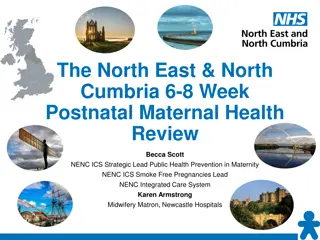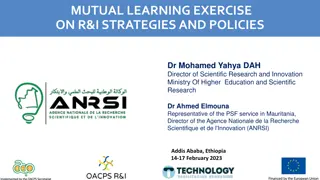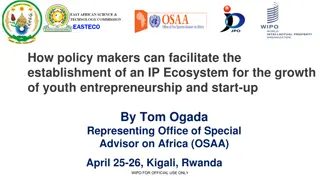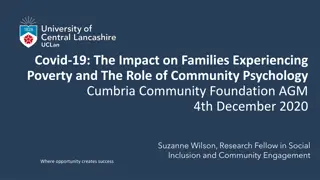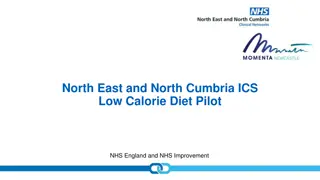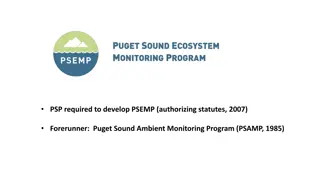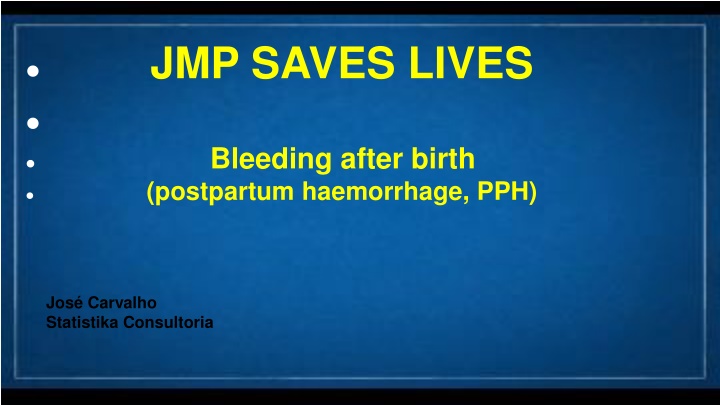
Innovation Ecosystem of Cumbria: Insights & Challenges
The Engineering and Physics Sciences Research Council (EPSRC) delved into the innovation landscape of Cumbria, highlighting a deficit in the wider economy despite pockets of strong innovation. The study conducted by EPSRC and Cumbria Local Enterprise Partnership (CLEP) revealed low collaboration levels and innovation activity in the region, contrasting with high self-reported rates. Cumbria's innovation ecosystem primarily revolves around the nuclear sector, with deep but narrow specialization, limited interconnections, and some technology spillover into other industries. The findings underscore the need for enhancing innovation networks and fostering collaborations for sustainable growth in Cumbria.
Download Presentation

Please find below an Image/Link to download the presentation.
The content on the website is provided AS IS for your information and personal use only. It may not be sold, licensed, or shared on other websites without obtaining consent from the author. If you encounter any issues during the download, it is possible that the publisher has removed the file from their server.
You are allowed to download the files provided on this website for personal or commercial use, subject to the condition that they are used lawfully. All files are the property of their respective owners.
The content on the website is provided AS IS for your information and personal use only. It may not be sold, licensed, or shared on other websites without obtaining consent from the author.
E N D
Presentation Transcript
JMP SAVES LIVES Bleeding after birth (postpartum haemorrhage, PPH) Jos Carvalho Statistika Consultoria
Bleeding after birth (postpartum haemorrhage, PPH) 125000 deaths/year Cause of 11% of maternal deaths in the US Definition (WHO, 1990): PPH: Blood loss volume > 500 mL in 24h after delivery sPPH: Blood loss volume > 1000 mL
Main causes of PPH Uterus atony 90% Trauma 7% Placental tissue retention and Coagulation system failure 3% Drugs and new physical devices are being developed to prevent PPH. They have to be tested in clinical trials
Clinical trials for PPH The WHO conducted three very large trials Trial Sites Countries NI margin for RR PPH N, trial size sPPH 1.35 Misoprostol (2001) ... 9 18530 Active Management (controlled cord traction) (2012) Carbetocin (2018) 16 8 1.30 24390 23 10 1.16 1.23 29645
Clinical trials for PPH The primary outcomes were sPPH and/or PPH Observations were volumes (mL) of blood loss Only the indicators of sPPH and PPH were considered in the statistical analyzes
Oxytocin Carbetoci n Standard therapy for PPH prevention Heat- labile Reduces sPPH rates 3.84% to 2% Heat- stable
Clinical trials for PPH Sample size, carbetocin trial p(sPPH | oxytocin)=2% p(sPPH | placebo)=3.84% Objective to preserve 75% of the benefit of oxytocin ==> margin: 0.46% 2.46/2 = 1.23 for RR Resulting sample size: 29645 patients randomized
Clinical trials for PPH Clinical trials for PPH Why are the trials so large? The proportions being compared are small The effects are also small A great deal of information is lost by mapping V into two categories
JMP helped us to discover that the distribution of blood loss volume is lognormal This fact will allow the estimation of the proportion of outcomes with better precision Therefore, it will lead to a decrease in the experiment sizes, keeping the precision requirements JMP also helped on the communication of the discovery to the investigators
A sidetrack problem: blood loss measurement Misoprostol trial Volume was measured on a graduated vessel, by direct reading Measurement replaced by gravimetric method for the carbetocin trial
Carbetocin trial Planning a noninferiority trial Expected proportion ocytocin (sPPH) = 2% proportion placebo (sPPH) = 3.84% Keeping 75% of the benefit: 1.84*(1-0.75) ==> margin 0.46% Limit for noninferiority: 2+0.46=2.46% In relative risk terms: 2.46/2 = 1.23 Risk (carbetocin/ocytocin) < 1.23 for noninferiority
Sample size Relative Efficiency of Binomial vs lognormal based analysis For simplicity, let us consider the case of testing the superiority of a new drug over the standard ocytocin, for which p(V>1000)=0.02. We want to declare the new drug superior, if p(V>1000) < 0.015 H : p = p = 0.02 H : p < 0.015 Power = 0.8
Sample sizes H : p = p = 0.02 H : p < 0.015 Power = 0.8 Binomia l ? ? > 1000 ??? ? ? Lognorma l >??? 1000 ? = ? ? ? H : m = m = 5.4701 H : m < 5.3887 D = 0.0814 =0.02 ? ? =0.015 >??? 1000 ? 0.7
Sample sizes H : p = p = 0.02 H : p = 0.015 Power = 0.8 With the binomial: total n = 17004 H : m = m = 5.4701 H : m = 5.3887 With the lognormal: total n = 1832 D = 0.0814 Efficacy: n binomial / n lognormal = 9.3
We have shown that: The lognormal distribution fits very well the blood loss volume distribution By using this fact, the estimates of p(sPPH) and the relative risk is more precise The trial was saved by showing noninferiority of carbetocin New trial is underway, now using the lognormal. It is going to be completed faster and is more economical. Even the data quality is expected to be better.
SAVES LIVES? A clinical trial is always a burden on the participants. Reducing trial size by that much... Faster acceptance of a new good treatment also will save lives.
Reference s Carroli, G., CristinaCuesta, Edgardo Abalos, A. Metin Gulmezoglu: Epidemiology of postpartum haemorrhage: a systematic review. Best Practice & Research Clinical Obstetrics and Gynaecology Vol. 22, No. 6, pp. 999 1012, 2008 doi:10.1016/j.bpobgyn.2008.08.004 available online at http://www.sciencedirect.com G lmezoglu AM, Villar J, Ngoc NT, Piaggio G, Carroli G, Adetoro L, Abdel-Aleem H, Cheng L, Hofmeyr G, Lumbiganon P, Unger C, Prendiville W, Pinol A, Elbourne D, El-Refaey H, Schulz K; WHO Collaborative Group To Evaluate Misoprostol in the Management of the Third Stage of Labour. WHO multicentre randomised trial of misoprostol in the management of the third stage of labour. Lancet. 2001 Sep 1;358(9283):689-95. doi: 10.1016/s0140-6736(01)05835-4. PMID: 11551574. G lmezoglu AM, Lumbiganon P, Landoulsi S, Widmer M, Abdel-Aleem H, Festin M, Carroli G, Qureshi Z, Souza JP, Bergel E, Piaggio G, Goudar SS, Yeh J, Armbruster D, Singata M, Pelaez-Crisologo C, Althabe F, Sekweyama P, Hofmeyr J, Stanton ME, Derman R, Elbourne D. Active management of the third stage of labour with and without controlled cord traction: a randomised, controlled, non-inferiority trial. Lancet. 2012 May 5;379(9827):1721-7. doi: 10.1016/S0140-6736(12)60206-2. Epub 2012 Mar 6. Erratum in: Lancet. 2012 Jul 21;380(9838):218. Erratum in: Lancet. 2012 May 5;379(9827):1704. PMID: 22398174. Widmer M, Piaggio G, Nguyen TMH, Osoti A, Owa OO, Misra S, Coomarasamy A, Abdel-Aleem H, Mallapur AA, Qureshi Z, Lumbiganon P, Patel AB, Carroli G, Fawole B, Goudar SS, Pujar YV, Neilson J, Hofmeyr GJ, Su LL, Ferreira de Carvalho J, Pandey U, Mugerwa K, Shiragur SS, Byamugisha J, Giordano D, G lmezoglu AM; WHO CHAMPION Trial Group. Heat-Stable Carbetocin versus Oxytocin to Prevent Hemorrhage after Vaginal Birth. N Engl J Med. 2018 Aug 23;379(8):743-752. doi: 10.1056/NEJMoa1805489. Epub 2018 Jun 27. PMID: 29949473. Piaggio G, Carvalho JF, Althabe F. Prevention of postpartum haemorrhage: a distributional approach for analysis. Reprod Health. 2018 Jun 22;15(Suppl 1):97. doi: 10.1186/s12978-018-0530-7. PMID: 29945633; PMCID: PMC6020008. Carvalho JF, Piaggio G, Wojdyla D, Widmer M, G lmezoglu AM. Distribution of postpartum blood loss: modeling, estimation and application to clinical trials. Reprod Health. 2018 Dec 4;15(1):199. doi: 10.1186/s12978-018-0641-1. PMID: 30514326; PMCID: PMC6280488.





